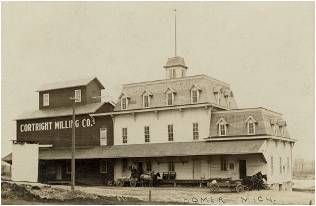|
A Look Back in the History of The Homer Mill
Located in Calhoun County, Michigan sits the village of Homer, which was settled in 1832 by Milton Barney, who originally named it Barneyville. In 1834, Barneyville was renamed Homer after the city in Courtland County, New York. It wasn’t until 1871 when Homer was incorporated as a village. The village has a total area of 1.5 square miles. Today there are an estimated 1800 residents residing there. If anyone has ever been to Homer, or lives in Homer, they can tell you the one building that everyone knows; The Homer Mill. It stood four stories high, and was the first structure you would see before you entered the town as you are driving along Highway 60. The Homer Mill was a haunted themed restaurant and bar, along with a haunted house during Halloween. If you wanted good food, good people and a scare, you would head to The Homer Mill. Once inside the mill, it was filled with amazing Hollywood inspired props.
Underneath all those props, though, you could see the remnants of when it operated as a flour mill. Many of the gears, and supplies were still inside the mill. Every Halloween, the haunted house would open, and hundreds of people from and around Homer would come out to enjoy the frights. Even Alice Cooper would make appearances at the Mill, and they even had his autographed chair located inside the mill. The Homer Mill was built on the site of the original mill, at the banks of the Kalamazoo River, which was built in 1837, by the town’s first settler, Milton Barney, and completely burned to the ground in 1886. C.C. Cortright and son erected the turbine driven mill in 1887 under the contractor George McCartney, who finished the job in just 60 days. Later in 1910, large additions had been added. The mill operated as a flour mill with the Cortright’s as owners until 1940 when the H. Van Patten Company purchased it from the Cortrights. It operated under the name Cortright-Van Patten Milling Company until it stopped running as a mill in 1970. In 1974, the mill was purchased by James L. Miller, who did a complete cleanup, and opened it as The True Grist Ltd dinner theater. It operated as a dinner theater until 1987, putting on live plays such as “The Mouse Trap,” and “Barefoot in the Park.” The actors lived on the fourth floor of the mill, and put on live shows all year long. Nearly every show was reviewed in the Enquirer. Audiences came year round, and shivered in the winter, and fanned themselves in the summer. Sadly the theater was closed down by the IRS due to behind tax payments. The mill became listed on the National Historic Registry in 1979. In 1991, the mill was purchased by John and Alice Blakemore, and it became the Blakemore’s Historical Grist Mill Ltd restaurant and lounge. The Blackmore’s worked very hard on getting everything in place for their business. They even wanted to turn the upper stories into a bed and breakfast. The Grist mill eventually evolved into the Homer Mill Extreme Haunted House, owned by Lance and Susan Cuffle. Sadly, The Homer Mill burned completely to the ground on May 16, 2010. Nothing could be salvaged. We at LMPS had the great opportunity to come into the Homer Mill, and investigate it. We send out many thanks to Lance Cuffle for allowing us to do so. We were able to see behind the scenes, that not everyone could go back and see. We were on every floor and even in the cellar of the mill. We caught some of our greatest evidence here. Some of the ghostly stories told were one of two children who unfortunately were swimming in the Kalamazoo River near the mill, and were pulled into the mill, and killed. One was a boy, and one was a girl. We believe we came in contact with the little girl who was known to haunt the basement where they died. At the mill, they called her “Amy.” There was another story that was told about a little boy outside the mill that would be seen wearing red tennis shoes. Could this be the little boy? There was story as well about the foreman who worked at the mill, who died tragically when he fell into a silo of grain and suffocated. Another part of this story is that the owner’s wife hanged herself upstairs. WE have no proof of any of this, and until we do extensive research, we cannot say it did or didn’t happen. While being in the mill, we did notice old fire damage. We had been told that there had been a fire in the mill while it was operating as a flour mill. There was evidence of this upstairs on the beams. We find it strange that the original mill was destroyed by a fire, then rebuilt, and still had fires inside, that never quite injured the mill, and then 120 years after being built a second time, the Homer Mill burns completely to the ground. Coincidence?? We want to send out our many thanks to Lance and Susan for allowing us the opportunity to investigate in their building. We also send our deepest apologies for the loss of this wonderful historical landmark. We wish them luck, and hope that they can rebuild, and have wonderful memories of the Homer Mill. |
